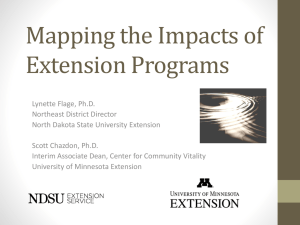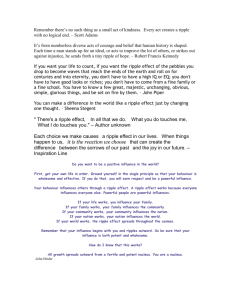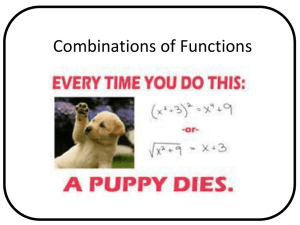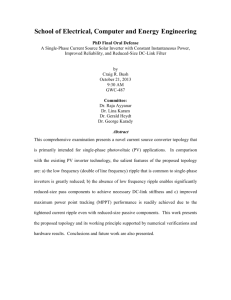PFC/RR-80-13 C L. Bromberg and UC-20
advertisement
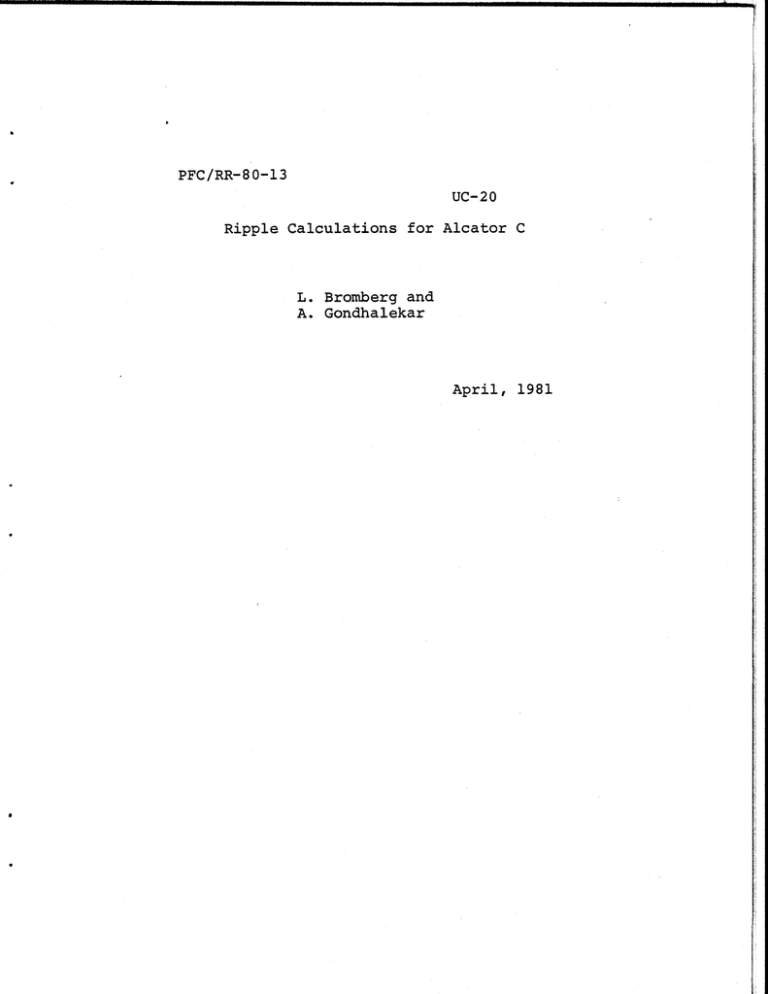
PFC/RR-80-13 UC-20 Ripple Calculations for Alcator C L. Bromberg and A. Gondhalekar April, 1981 RIPPLE CALCULATIONS FOR ALCATOR C L.'Bromberg and A. Gondhalekar PFC/RR-80-13 August 1980 RIPPLE CALCULATIONS FOR ALCATOR C L. Bromberg and A. Gondhalekar Abstract: Thc current distribution in ALCATOR-C is calculated using a two dimensional model. The resulting current distribution is used to calculate the toroidal field ripple. Current distribution in ALCATOR-C The geometry considered is shown in Figure L In calculating the current distribution in the B17TER plates it is assumed that the torus is symmetric in the toroidal direction. The penetration of the field in a conductor with non-uniform conductivity is given by B =-V x -V XB where B is the magnetic field, p. is the permeability of free space and a is the non-uniform conductivity. In toroidal coordinates (shown in Figure 1), this equation reduces to 8B4 10( 1 r IT r =4 + p,r L c ((R + r cosR)Br0 - ((R + r cos0)B.) a r(R + r cos0)OB 1 where BO is the magnetic field in the 0 (toroidal) direction. R is the major radius of the torus, r is the minor radius coordinate, 0 is poloidal angle and4) is the toroidal angle (see Figure 1). or is defined by I o=f(r,)( (c.(T) + 1 --cm.. where f(r, 0) is the copper filling factor of the coil and T is the copper tempcrature at the same radial location. acc is the conductivity of copper. or, represents the magneto-resistivity and is given by rnag = 2.2 10O0/B(r,G) whereB(r, 0) is in T. The copper filling fraction is given by ,) 0.72 =1 R + rcosO whereR and r are in m (this takes into account the stainless steel reinforcing and the insulation). The boundary conditions are BO(r = b, 0) =0, BO(r = a, 0) B(t)R R + rcos# where a and b are the inner and outer minor radii of the torus (see Figure 1). In the case considered here, a = 0.2 m, b = 0.4 m andR = 0.64 m. It is assumed that B(1) (the field at the minor axis of the bore) is increased linearly in 0.5 s. The flat top value of the field B is 8.0 T. 2 The temperature of the conductor is solved using C OT -= 1 -(j(r,0)) 2 where c, is the heat capacity and p is the density. j(r, 0) is the average current density at position r, 0 and is given by (,)= 1 -V XB It is assumed that the copper and the reinforcing structure are at the same temperature. It is also assumed that the heat capacities and the densities of the reinforcing structure and the copper conductor are equal. Figure 2 show contours of constant current density -in the magnet 200 ms after the beginning of the flat top. The current is concentrated near the bore of the TF coil all around the torus. Figure 3 and 4 show contours of constant current density 1 s and 2 s after the beginning of the flat top. Note that by this time the current has already permetaed the copper conductor of the toroidal field coil. Figure 5 shows the temperature distribution for the same conditions as Figure 4. 3 I Ripple calculations The current density calculated in the previous section is used to determine the toroidal field ripple. The BITTER plates are simulated by a set of nonconccntric poloidal rings. The current in each of these rings is such that the current density calculated in the previous section is approximately reproduced. A study on the number of rings per plate required was carried out: four rings per plate are sufficient. Two types of plates are assumed: thin and thick plates. The geometry choosen is such that the diagnostic flange geometry is reproduced very well. However the split flange geometry near the throat of the magnet is not. In ALCA TOR-C there are 4 diagnostic flanges and 2 split flanges. Figure 6 shows contours of constant toroidal field ripple calculated at the location of a diagnostic flange 200 ms after the initiation of the flat top; at this time the current density is the one shown in Figure 2. The ripple is defined by B0 4 B , ~~'B4 - ,~ where B0 is the value of the toroidal field at a given location and BO4,,,, is the average of the toroidal field at the same major radius position. The ripple is large (- 6% at the limiter, a = .16 m and - 1% at the plasma axis). The ripple is approximately constant around the poloidal direction (this is true only around the flange location, as will be discussed later). Figure 7 shows contours of constant toroidal field ripple on the midplane of the machine for the same conditions as figure 6. One half of a sextant is shown. The flange is located at 0 ~r/12. 4 = 0 correspond to the position in between flanges. The ripple decreases to lower values (- 1%) away from the flange location. The ripple at the outer edge of the plasma has a minimum at the position of the flange (~ -6%), then goes to a maximum of- 2% and has another minimum (- 0. %) in between the flanges. Figure 8 shows the field ripple on the surface r = .1 mas a function of the poloidal and toroidal angles for the same conditions as figure 6. Note that the ripple is about constant at the position of the flange. 4 Figure 9 shows the value of the toroidal field ripple 2 s after the beginning of the disharge. By this time, the currents have approximately reached a quasi-steady distribution on the BITTER plate (heating of the throat still produces changes in the current distribution). The ripple at this time is 40% smaller than at 0.2 s after the beginning of the discharge. It is possible to vary the ripple significantly (by about - 40 %)by varying the timing of the discharge with respect to the flat top of the field and the ramp-up time. It should be stressed that these calculations are preliminary, in that the ripple near the split flanges has not been calculated. Because in the throat region the split flanges have larger dimensions than the diagnostic flanges, the ripple produced by them can be expected to be larger than the ripple values presented here. 5 z R0 r o. 0 Figure 1 R Toroidal coordinatos R w 0U 4J In 0 I 0 w .1-I 5.4 JJ *aJ *1-4 0 J.J 0 i '.4 '.4 0 -~ 0 'I m 9 U ~.4 0 '.4 0 J.J 0 C., * c.,l 0 '.4 IZd r0. 4J V0 V. 0 4 C0 0 U oM ca1 -A r4 Lf0 0 $4. II.' c;J 02 P4 NI 00 Lf2 4 0 L.IJ m 0) * 0 451 *0 I-I. 0 I.. NL ta * '41 In 0 4IJ '.4 0 '4 I ci- I I 0 0 * C * 0 0 0 0 U U ~0 d 0 I-' *8 * 00 4 C: 44- 0 .14 LIn 0 0; dn 0 Ai 0 U '-I 0a Ui .4. Vr4 . . *r *IJ& dn In .D .4. 00 I) 0* 0-4 In 0 0 .4 LA m In. c C -iiilui &I Cf %D - CDC 0 4 '4 cc co .1. C 0-41 54 00 uw 00 Ci Cr . . . .1 - I i 0 0 bo 0L 4.4 Ln '-4 '4 * a I 0 0L 0 * 0 0 41 0 L) 0 .8 *r4 3


